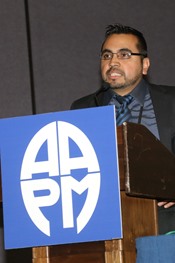Program Information
Fringe Stability and Phase Shift Measurements in a Michelson Interferometer for Optical Calorimetry
E Flores-Martinez1*, M Malin1 , L DeWerd2 , (1) UW-Madison, Madison, WI, (2) University of WI-Madison/ADCL, Madison, WI
Presentations
SU-E-T-410 Sunday 3:00PM - 6:00PM Room: Exhibit HallPurpose: To identify the variables limiting the resolution of a Michelson interferometer used to measure phase shifts (PS) in water as part of a radiometric calorimeter.
Methods: We investigated the output stability of a He-Ne laser and a laser diode. The short and long term stability of the fringe pattern in a Michelson interferometer was tested with different types of lasers, thermal insulation arrangements, damping systems and optical mounts to optimize system performance.
PS were induced by electrically heating water in a 1 cm quartz cuvette located in one of the interferometer arms. The PS was calculated from fringe intensity changes and compared to a calculated PS using thermocouple-measured temperature changes in the water.
Results: The intensity of the laser diode is more stable, but the gas laser’s profile is more suitable for fringe analysis and has better temporal coherence. The laser requires a warm-up time of 4 hours before its output is stabilized (SNR>95).
The fringe’s stability strongly depends on the thermal insulation. When the interferometer is exposed to ambient temperature swings of 0.7 K, it is not possible to stabilize the fringe pattern. Enclosing the system in a 2.5 cm-thick Styrofoam box improves the SNR, but further insulation will be needed to increase the SNR above 50. High frequency noise is significantly reduced by damping the system.
Inducing a temperature rise in water, starting at 299 K, the average temperature increase for a 2π PS is 0.29 ± 0.02 K and the proportionality constant is -21.1 ± 0.8 radians/K. This is 5.8% lower than the calculated value using the thermocouple.
Conclusion: Interferometric PS measurements of temperature may provide an alternative to thermistors for water calorimetry. The resolution of the current prototype is limited by ambient temperature stability. Calculated and measured thermally-induced PS in water agreed to within 5.8%.
Contact Email:


